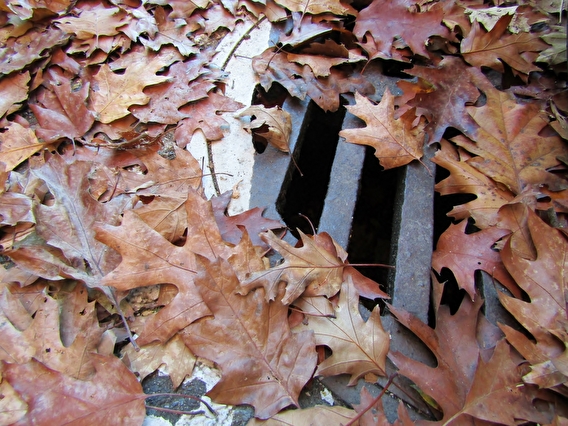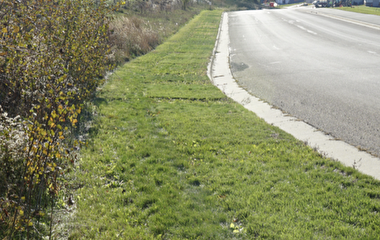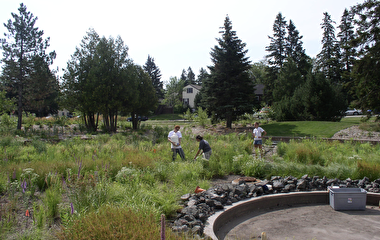
Strategies for managing stormwater runoff have been steadily undergoing a shift in recent decades toward “green” infrastructure. This is a potentially beneficial change, but transportation professionals are beginning to recognize a need for better information on how to properly design, implement, and maintain these facilities.
CTS hosted a webinar on April 8 that brought together transportation researchers and professionals to discuss best practices for implementing green infrastructure. Professor John Gulliver of the U’s Department of Civil, Environmental, and Geo- Engineering gave a presentation on the subject, after which a panel of local and state government representatives discussed their own practical experiences.
“There’s a lot of runoff in an urbanized land cover,” Gulliver said. Impervious surfaces such as concrete tend not to allow stormwater runoff to absorb into the soil, and this in turn can cause increased flooding, erosion, and movement of pollutants.
Green infrastructure, in comparison to the more traditional, concrete-based “gray” infrastructure, tries to mitigate these problems by mimicking the natural water cycle and utilizing processes such as infiltration to treat stormwater at its source. It can be used very effectively, Gulliver said, but each green best management practice (BMP) has limits and considerations that must be accounted for.
Initial design is key to the success of a BMP, Gulliver said. Infiltration systems, for example, can fail to do their job from day one if the surrounding soil texture and structure are not taken into account. High groundwater can cause infiltration failure, and Gulliver’s research is finding that plant roots play a huge role in increasing the porosity of the soil.
“If you take a soil profile at one location, that may not tell you what the whole practice is going to do,” Gulliver said.
Maintenance is also an important consideration. Gulliver’s research is finding, for example, that the sediment in stormwater ponds sometimes reaches a failure point and re-releases sequestered phosphorous. This can be prevented through regular sediment dredging, but many ponds were not built with maintenance logistics in mind.
“If these BMPs are going to be sustainable structures, you’re not just going to build them and walk away,” said Mark Maloney, director of public works for the City of Shoreview. Local governments, he said, need to have the “organizational courage” to budget for BMP longevity.
Dwayne Stenlund, an erosion control specialist with the Minnesota Department of Transportation, suggested that operator’s manuals would go a long way toward helping cities plan the logistics and resources needed for maintaining BMPs. He recommended that the manuals include facility specifications, maintenance instructions, and a list of the staff, materials, and money necessary for long-term upkeep.
Ross Bintner, division manager for the City of Edina Engineering Department, added that these BMPs also need to be installed with a systems approach, since the hydrology of one parcel of land inevitably affects that of its neighbors.
Mike Trojan, hydrologist with the Minnesota Pollution Control Agency, said that MPCA manuals do provide some state-level guidance on green infrastructure. However, new information regarding operations and maintenance—such as phosphorous management and soil and vegetation factors—needs to be considered. “We need to build that into the initial considerations at a site,” he said.
There is also the question of equity. Stenlund noted that there is often a disparity between stormwater funding and poor/minority communities—wealthier communities tend to get far better access to funding for green initiatives and maintenance.
The panel discussed using a more community-oriented approach to potentially address these issues. Stenlund pointed out that maintenance operations tend to languish in obscurity, and he suggested that overcoming this trend could improve design and budgeting decisions within the community.
“We always have a ribbon-cutting when we build a new bridge,” Stenlund said, “but when have we ever had a ribbon-cutting event saying, ‘Maintenance, you did a great job this year’?”
The webinar was held in conjunction with a joint meeting of the CTS Transportation Infrastructure Council and the CTS Environment and Energy in Transportation Council.
Writer: Sophie Koch


